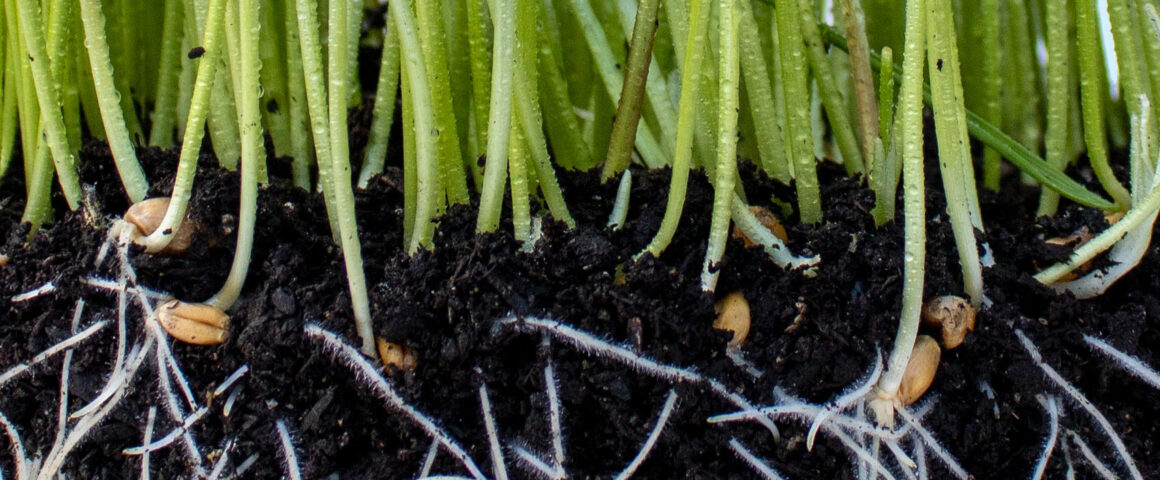This sampling of two gleanings (from over 50 I’ve stumbled upon in my 22 years as a California Poet in the Schools) is excerpted from my book, Tending the Roots in a S.T.E.M-Craze World: Gleanings from a Curriculum in Wonder. This part memoir, part socio-educational treatise, part guidebook poured out in a flash flood when I retired from classroom teaching in 2021. It is my offering, as grateful witness in an increasingly left-brained, heart-hardening world, to the healing power of making poems.
•••
The primary root, the first organ to appear when a seed germinates, is called a radicle—an intriguing word considering its twin brother “radical”—which, though we’ve come to use the word for far flung changes in direction, in its original figurative usage, meant back to the origin. A plant’s radicle—the essence/origin of all that will come to fruition—breaks through the shell of the seed and grows downward into the soil, anchoring the seedling and allowing stems, leaves, and all the rest to issue forth.
In terms of tending the seed, no matter how impatient we might feel, we cannot pry it open, pull out its radicle, and expect the plant to thrive. Our job as gardeners, as educators and encouragers, is to create conditions that invite a seed to break through its protective cover and send its roots exploring.
From my own time mucking about in gardens, I know the prime ingredients that promote roots are a little sun and a little rain. I would also add that the germinating plant needs a little gravity to pull it deeper into the earth, plus a dose of gravity’s mysterious upward-reaching opposite—the force that propels it into the light.
As an educator, I’ve tried many practices to create such an inviting climate in a classroom. This is what I have discovered: the sun comes through when we ask students what they like, when we are generally curious about what they find interesting. Early on in my teaching career, I learned that the easiest way to shut down wonder in a writing workshop was to ask what a poem or its lines mean. (For one thing, I can assure you from the other side of the writing desk that many, if not most, poems are enigmas to their own poets!) Poetry is such that I don’t think it’s necessary to know exactly what a poem “means.” A poem’s work is to open us, get us wondering, and so:
#5 – Whenever we read a poem together, it’s every student’s job to find one thing they like—or at least find interesting—in the poem.
I tell them ahead of time: “I don’t like anything” is not an acceptable response. I tell them we are working the poetic muscle inside, which is open-minded and not quick to dismiss the unfamiliar or strange. Your response also needs to be true, of course, I tell them, so you’ll have to pay close attention to what happens inside your body as you read. Ultimately though, their job description is loose: it can be a few words, or even a single word, they find interesting. It can be an image that comes to them as they read the poem or the way certain words “sound” together. Or maybe they like something about the whole of it.
Students often surprise me in response to this assignment. Even the most reticent can usually find one thing, if offered a little patient encouragement. I have used this approach for years with my incarcerated students at Juvenile Hall (called Juvie, with ironic affection). While most of my fellow poet-teachers at Juvie keep to streetwise rap poets, much to their astonishment, I have often brought in the nature poet Mary Oliver. Yes, at first, the Juvie students looked at me and these poems with a scowl that said, “Are you for real?” But each time, the students were able to find one thing they at least somewhat liked: a few words that seem strangely new, a moment in the poem that reminds them of a moment in their own lives.
For example, Oliver’s poem “The Starfish” is, on its surface, a detailed encounter with the creature in a tide pool, but upon examination, it touches on the universally relatable struggle between attraction to and repulsion from “the strange.”
In the poem’s second stanza, Oliver reaches for a metaphor to highlight the weirdness of the five-limbed creature’s form and decides on “too many thumbs.”
“Okay,” admits one of the Juvie students. “‘Too many thumbs,’ gives me a pretty strange feeling. I guess I find that interesting. . . . I wonder what that’d feel like . . . to move around with too many thumbs.”
Soon one of the other students points to the poet’s unsettling question: What good is “loving what is easy?” and Oliver’s frank retort: “It never grew easy . . .”
“I can relate to that,” she admits. “It ain’t easy; I can tell you that.”
We move along, and each contribution opens the poem (and us) a little wider, until we reach the challenge at the end, which suggests we might, somehow, learn to love—little by little, as Oliver suggests, “our only world.”
Is this possible? To love this world? And isn’t it worth considering—that this world is the only one we have? Nobody needs to ask these things out loud; they fill the air around us. It really does seem like a kind of everyday magic—find one small detail to like in a thing, and one-by-one the doors swing open.
•••
#14 – Almost every question in poem-making can be met with a Yes.
Everything in the world began with a yes. One molecule said yes to another molecule and life was born.
–Clarice Lispector
One of poetry’s most endearing qualities is its immeasurable wingspan of “yes.” “Yes” is its method and mettle, its magic and its mantra.
“Can we start with our own idea?” Yes.
“Can we make up words?” Yes.
“Can we change where we are going in the middle of the poem?” Yes, yes, yes.
For many years, I have made it my most impassioned mission to reach the squirmy boys who wrestle for seats in the distant regions of our discussion circle. I see them as my ultimate teachers—those endless wrigglers who, in their joyful rebellion, almost never follow my prompts.
Today, an especially wriggly third-grader asks if, instead of choosing one of my carefully curated amorphous topics (echos, shadows, wind, clouds), he can write about parrots. “Great idea,” I say.
Wild-eyed (the way I love him most), he’s off to his desk to begin his poem, not by using the metaphor-making template I’ve designed, but by inviting his reader to come fly with him . . . and his parrots. He writes half-standing, hopping on one foot. And within minutes he’s bounced back to my side.
“Is this a good start?” he asks, fluttering the paper under my eyes. His penciled scrawl sings with an uncanny spirit of knowing: “Come with me. . . . I will take you. . . . I will show you. . . . Are you ready?”
“Yes!” I say, and call after him as he runs, “I want to see some of that wild imagination of yours!”
“Oh, you will!” He tosses the words over his shoulder. “I’ve got lots of wild imaginations to put in there!”
And so he does. He writes, propelled by a newfound creative spark. This child, who most days can barely get down two lines during our 20-minute writing sessions, fills two sides of his binder paper. And he is more than eager to read aloud to us all. We fly with him and his parrots; at one point he tells us to look down with him toward the earth below. “Colors in the water!” he exclaims.
“Water in the air!” The classroom teacher and I exchange expressions of what can only be called awe.
Next week, as we gather on the carpet to begin class, this nine-year-old boy, whose chosen spot was always on the farthest reaches of our circle, is sitting beside me. “I love poetry,” he says, eyes round and bright as harvest moons.
But that’s not all. As he sits to write, I notice a hefty copy of Robert Frost’s poetry on his desk. He must have spoken about his newfound love of poetry to the librarian or his parents. “Hmmm. . . . Robert Frost?” I say.
“Yup,” he says, almost nonchalantly. He opens the tome to a random page, and caught by sudden inspiration, points to a passage and adds: “I think I’ll take a line from here to start. . . . Is that okay?”
“Yes,” I say again. This is what Poet-Teachers live for, to say it again and again: “Yes. Yes. Yes.”
•••
So generous is poetry’s “yes,” it can absorb the most assertive “no” and give it life. For example, one morning Fred walked into his third grade classroom and loudly announced, “I ain’t writing no poem today!” He then proceeded to push two desks together against the back wall and lay himself across the tops of the desks, repeating his declaration to all the room: “Don’t expect no poem from me today!”
And there he settled, hands folded on his chest, looking up at the ceiling—dead-man style.
I let it go and went on to the experiment I’d planned for the day. Unbeknownst to Fred, he was in the perfect position for our lesson. Lying down is one of the most effortless and natural ways into Poetry Land. I ask the students to lay their heads on the desk as I play music and lead them on a tour of their own imaginations.
My preferred piece for this journey is Will Akerman’s masterpiece, “The Impending Death of the Virgin Spirit.” It is a collage of strings, his usual instrumental guitar flirting and mingling with violin. The effect is a sweet melancholy—a quieting depth-charge. I have watched students of all abilities and temperaments become still under its spell, and it’s long enough for a good journey at about five and a half minutes.
Most children are more than willing to put their heads down on their desks, but there are at least a few who are uncomfortable closing their eyes in a public space. To this “resistance,” I say yes.
“If you aren’t comfortable closing your eyes, just look down at the carpet or out the window. Just let yourself be alone so you can feel your way around inside. . . . I guarantee that if you stay with yourself through this journey, you will have plenty to write about.”
Which is exactly what happened to Fred. The music took him to the deep end of nowhere, where a poem began to make itself known, even for the boy who wasn’t “writing no poem today.” A poem he found quite good in the end, and even decided to share with the class.
For more, a pdf version of this book-in-progress can be downloaded from Prartho’s website: www.prarthosereno.com.
Prartho Sereno, Poet Laureate of Marin County, CA (2015-2017), has devoted her life to exploring and nurturing the creative process. It was her MA thesis topic in Counseling Psychology, funded by a National Science Foundation grant. Inspired by her research, she incorporated various art forms in her 15+ years work as a psychologist with troubled youth and their families, Alzheimer’s, psychiatric, and Hospice patients. She deepened her own practice for over four years in India, where she studied the effects of meditation on creativity. In 1999 Prartho became a California Poet in the Schools and was awarded a 2005 Radio Disney Super Teacher Award for that work. She earned an MFA in Creative Writing from Syracuse University in 2013 and is author of four national prize-winning poetry collections—Indian Rope Trick (2018), Elephant Raga (2015), Causing a Stir: The Secret Lives and Loves of Kitchen Utensils (2007) and Call from Paris (2007/14)—along with a collection of personal essays: Everyday Miracles: An A to Z Guide the Simple Wonders of Life (1998). A PDF version of Tending the Roots is available at her website: www.prarthosereno.com.



